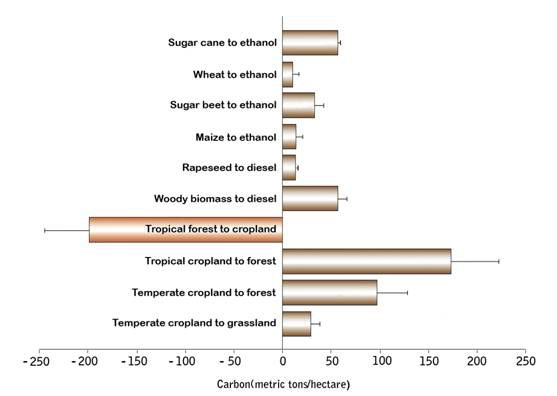Biofuels out forests in, scientists advise policy-makers to concentrate on increasing fuel efficiency in the short term and restoring unused croplands to forests. Selective harvesting of wood waste and biomass from standing forests may be sustainable. Dr. Mae-Wan Ho
Biofuels have been widely and mistakenly promoted for mitigating carbon missions as fossil energy is at or past its peak [1] (Biofuels: Biodevastation, Hunger & False Carbon Credits, SiS 33). Many critics have pointed out that biofuels compete for land that should be growing food, and furthermore, they give poor, even negative energy returns when proper lifecycle accounting is done [2] (Biofuels for Oil Addicts, SiS 30). More importantly, bioenergy crops are a strong driver of deforestation, which results in net release of huge amounts of CO2.
Rento Righelato of the World Land Trust, Suffolk, and Dominick V Spracklen at University of Leeds in the UK have compared the carbon mitigation potentials of various biofuels with other uses of the land required for growing the bioenergy crop [3]. As land is the limiting resource, they argue, the appropriate basis for comparison is the amount of C saved per hectare a year. A period of 30 years is used for comparison, which seems reasonable, as it takes time for bioenergy crop plantations to mature and for carbon stocks of cut forests to turn into carbon dioxide. Moreover, it would take that much time for ‘carbon-free’ fuel technology to be widely available.
Their results are summarised in Figure 1 (redrawn from [3]).

Figure 1. Carbon saved on different options
They have made no allowance for emissions arising from change in land use to produce the bioenergy crop. As can be seen, planting a forest in the same area of land would sequester two to nine times more carbon over a 30-year period than the emissions avoided by using biofuels.
Furthermore, large areas of land are needed to make significant quantities of biofuels. A 2004 report from the International Energy Authority [4] estimated that 10 percent substitution of fossil fuels would require 43 percent and 38 percent of current cropland area in the United States and Europe respectively. That means forests and grasslands would need to be cleared even at this low level of substitution. Clearing would result in the rapid release of carbon stores in the vegetation and the soil that would outweigh any avoided emissions.
The most disastrous option is to convert tropical forest into cropland, which results in a net loss (emission) of 200 t C/ha. The Stern Report on the economics of climate change [5] commissioned by the UK Treasury noted that putting a stop to deforestation is by far the most cost-effective way to mitigate climate change, for as little as $1/t CO2 [6] (see The Economics of Climate Change, SiS 33).
Righeleto and Spracklen point out that of the options for biofuels, only conversion of woody biomnass may be compatible with retention of forest carbon stocks, especially if it means making use of wood wastes and harvesting appropriately from standing forests. This would involve selective felling of the biggest trees, which has been shown to encourage the most carbon assimilation in new growth and result in the greatest benefit for biodiversity [7] (Multiple Uses of Forests, SiS 26).
If the prime object of the policies on biofuels is mitigating carbon emissions, Rigehleto and Spracklen note: “policy-makers may be better advised in the short term (30 years or so) to focus on increasing the efficiency of fossil fuel use, to conserve the existing forests and savannahs, and to restore natural forest and grassland habitats on cropland that is not needed for food.”
Apart from reducing net CO2 emissions, conversion of large areas of land back to secondary forest provides other environmental services, such as prevention of desertification and maintenance of regional climate regulation [8] (see Greening the Desert, How Farmers in Sahel Confound Scientists, SiS 37), providing forest products, maintenance of biodiversity.
The only ‘biofuel’ that is truly sustainable is methane from anaerobic digestion of biological and livestock wastes [9, 10] (see Biogas China, SiS 32; Biogas Bonanza for Third World Development , SiS 27).
Article first published 12/12/07
Comments are now closed for this article